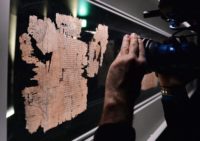 An ostensibly ancient document attributed to Greek geographer Artemidorus of Ephesos has been conclusively declared a fake after an extensive investigation by the Turin Public Prosecutor’s Office.
An ostensibly ancient document attributed to Greek geographer Artemidorus of Ephesos has been conclusively declared a fake after an extensive investigation by the Turin Public Prosecutor’s Office.
The ownership record was nebulous, a sadly common state of affairs for most of the papyri bought on the antiquities market. The claim was that the fragments of papyrus were part of a roll of random discarded documents that had been crumpled up together to stuff something, maybe an animal mummy. It was purported to have been acquired in the first half of the 20th century by Saiyd Khashaba Pasha and then lost or sold after World War II. It was exported out of Egypt legally in 1971 and imported into Germany by antiquities dealer Serop Simonian. The roll was unwrapped in Germany in the early 1980s and 200 document fragments were revealed, 50 of them from a single document.
It was puzzled back together and published in 1998. The recto consisted of three columns of prose, two drawings of bearded heads, 23 drawings of hands, feet and heads and a small section of a map. The verso was covered by more than 40 drawings of animals, each one named, and two more columns of prose.
The map alone was priceless, the most ancient extant one from the Greco-Roman world and the only one found on papyrus. The quantity and quality of the drawings are unique among papyri. The prose is an oddly convoluted discussion of geography. Fourteen lines significantly overlaps a surviving fragment of text by pioneering geographer Artemidorus of Ephesos who was one of the main sources used by later geographers and historians like Strabo and Pliny the Elder whose works have survived. The works of Artemidorus are largely lost, surviving only in quotations from the works of later authors.
In 2004, it was acquired by the Compagnia San Paolo Art Foundation, the non-profit foundation of Turin’s Banco di San Paolo, for 2.75 million euros ($3,369,850). The fragments were sent to the Laboratoria di Papirologia of the State University of Milan for additional study and conservation. The foundation wanted to donate it to Turin’s famed Egyptian Museum, the largest collection of Egyptian antiquities outside of Egypt, but the then-director of the museum, Eleni Vassilika objected strenuously. She didn’t trust its provenance. To be more specific, she knew for a fact that Simonian trafficked in fakes having dealt with his shenanigans when she was director of the Hildesheim museum. She also knew that he had a nasty history of smuggling artifacts in through Switzerland, going so far as to saw the larger ones to make them easier to conceal in shipment.
Her superiors disagreed. Many prestigious, reputable experts attributed the papyrus to Ardemidorus of Ephesos. Radiocarbon testing found the papyrus dated to between 15 and 85 A.D. and the ink was judged consistent with the types produced in the 1st century. The issue was far from decided. Scholars continued to debate its authenticity. Luciano Canfora proposed in several papers, books and articles published from 2007 onwards that it was a fraud perpetrated by notorious 19th century forger Constantine Simonides. His contentions were hotly debated by scholars who pointed to the C14 dating of the papyrus and authentic-seeming stylistic elements as evidence of it being a real 1st century document, albeit an idiosyncratic one.
A 2013 publication by Canfora caught the attention of the Turin Public Prosecutor’s Office which initiated an investigation in 2013. Five years later, the investigation has concluded that the preponderance of the evidence points indicates that the Artemidorus Papyrus is indeed a fake. The ink from the drawings, previously untested out of preservation concerns, is much more recent than the 1st century. The papyrus shows signs of having been placed on a zinc metal screen and then subjected to treatment with acids that transferred the zinc.
The documentation tracing its recent history — the legal export authorization from Egypt dated April 1971 in which it is destribed as “paper bag with partial images in gold,” the German government’s release of the papyrus at the time of the 2004 sale describing it as being nothing of value to cultural patrimony — dismisses it as worthless. Egypt appraised its market value as 20 lire.
Unfortunately nothing will come of this finding beyond a few red faces. The statute of limitations has long since expired, so the foundation is out 2.75 million euros and Serop Simonian will get off scott free.
What a pity. And not just because of the money.
Too bad Ad Bestias is no longer proper form to deal with critters such as Mr. Simonides.
Too bad Ad Bestias is no longer proper form to deal with critters such as Mr. Simonian. Name correction – should have been fully awake before commenting.
Is it easier to fake inscribed stones – easier in the sense that the stone offers fewer clues than a papyrus-and-ink artefact does?